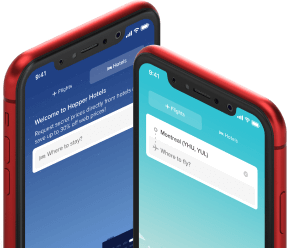Booking Strategies For The Modern Traveler
6 Truths You Need To Know About Airfare In 2019

Patrick Surry - Wed Mar 13 2019

Spring travel is here and with it a chance to put your booking strategies to the test. But are you relying on old myths? Hopper analyzed its archive of tens of trillions of flight prices to determine the 6 truths you need to know about airfare in 2019. With prices currently averaging $516 round-trip, you could save up to $292 on that spring getaway if you do everything right. Read on for the new rules of flight booking.
<center>WHAT TO KNOW ABOUT: FLIGHT TYPE</center>
1. Non-stop vs. one-stop
Myth: Non-stops are always more expensive
Truth: On average, you can save 5% ($25 off the average spring ticket) by taking a one-stop flight, or an incremental 2% ($36 total) by going from a one-stop to a two-stop. However, there are an increasing number of non-stop flights available now that are cheaper -- one in every three queries, to be exact. These savings can typically be found in markets where low-cost competition is driving down prices overall.
2. Basic economy vs. economy
Myth: You’ll always save money by taking a basic economy flight
Truth: You can save an average of 5% ($25 off the average spring ticket) by taking basic economy vs. economy. However, you’ll need to anticipate paying extra for things like baggage, seat assignments, ancillaries, etc. Depending on what your flight needs are, you may end up paying less if you book economy.
3. Early bird vs. night owl
Myth: You have to take a redeye to get the cheapest fare of the day
Truth: Time of day doesn’t have a major impact on flight cost, but if you want to get marginal savings, you should consider flying between 4-8AM for an average of 2% ($10 off the average spring ticket) off your flight price. You save an average of 3% ($15) by taking a return flight in the morning compared to one late in the afternoon or evening.
4. Weekend vs. weeknight trips
Myth: Trips that include the weekend are always more expensive
Truth: With the exception of flights to the Caribbean (which has a 6% premium for Saturday night stays), all other destinations have a discount with a Saturday night stay. Want to get the most savings? Head to Europe -- the average discount is almost 40% ($206 off the average spring ticket) for including a Saturday night stay. Domestic flights and international flights to Canada, Oceania, Mexico, and Central America offer savings of less than 3% ($15).

<center>WHAT TO KNOW ABOUT: WHEN TO BOOK</center>
1. When to buy
Myth: Purchase your flight as far in advance as possible to get the best deal
Truth: While everyone know there’s such a thing as booking too late, what’s surprising is that there’s also such a thing as booking too early. Flights go on sale 11 months before departure, but don't expect to catch deals more than 150 days prior to takeoff. Booking more than six months ahead can cost you since airlines set their initial prices conservatively.
When that sweet spot is exactly can vary drastically from route to route - a key reason Hopper was developed to keep track of and predict future prices. Start tracking your prices early - the average Hopper user starts watching a trip 3-4 months in advance - so that you never miss a deal.
If you're trying to shop online for deals, you'll likely miss out because you're only spot checking prices. We found that airfare often fluctuates 5-10% within a single day. All that price variability means there are great deals available, but it's unlikely you'll be able to spot those price drops unless you refresh your search all day. That's why it's important to use a tool like Hopper which monitors billions of fares in real-time.
The graph below shows how far in advance Hopper typically alerts users to buy to get the best deal for each destination region.
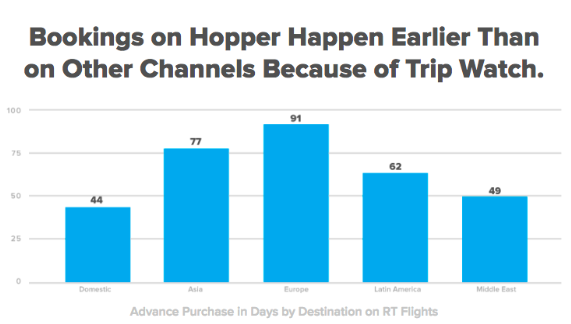
Here’s how much you can save by following Hopper's advice on when to buy. We calculated savings by looking at the first price a user saw compared to when Hopper sent them an alert saying to buy:
Domestic U.S. - $52 savings
Europe - $161 savings
Asia - $104 savings
Australia - $156 savings
South America - $90 savings
Here are two key factors that determine the “when to buy” sweet spot:
Business or leisure
Business routes, like San Francisco to Boston (solid blue line), tend to have low, slightly declining prices at long advances with prices and demand then rising very rapidly prior to departure. The optimal time to buy for this particular route is 27 days in advance.
However, more consumer-oriented markets like San Francisco to Honolulu (solid pink line above) are booked much farther in advance, and have a much smaller last-minute premium. The optimal time to book this trip is 113 days in advance (3+ months). However, you won't pay as much of a price premium if you wait until the last minute to book on a leisure route.
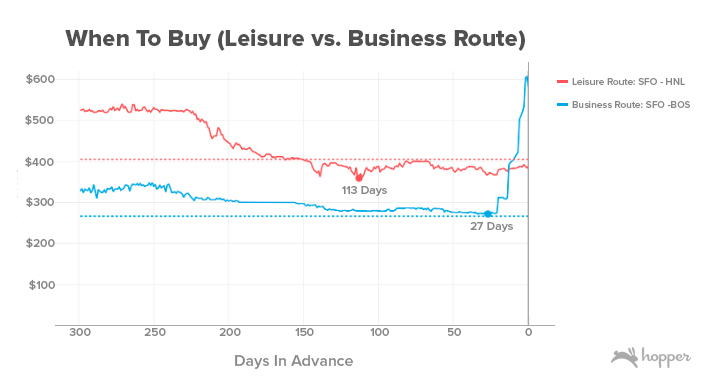
2. Type of flight
The type of flight you’re looking for can also impact the best time to buy. For example, the graph below shows the price trend for a trip from New York to Rome. The pink line shows when Hopper would alert you to buy the cheapest nonstop, while the blue line shows when Hopper would alert you to buy the cheapest overall flight.
The cheapest option is nearly flat, with the best prices appearing over four months before departure. On the other hand, the best price for the nonstop is available about three months before departure. This is part of the reason Hopper will update it’s price prediction if a user chooses to exclude basic fares and flights with stops from their Watch Filters.
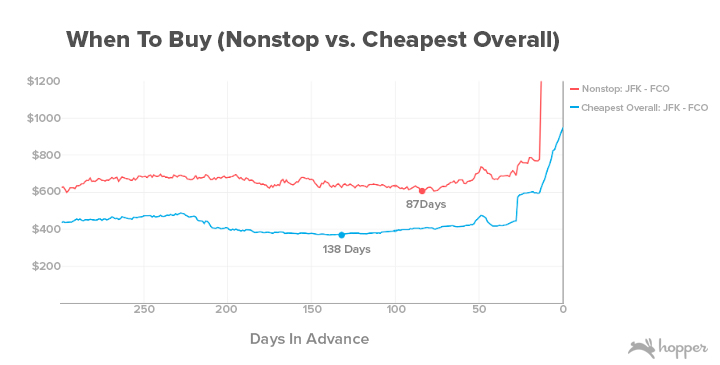
2. Shopping on the weekends
Myth: You’ll find more flight deals if you shop on the weekend
Truth: You’re less likely to find a flight deal if you’re shopping at predictable times. It can be difficult to plan leisure trips during work hours so most people put it off until the weekend. However, we analyzed which days of the week Hopper detects the most deals and, therefore, sends a "buy now" notification to users.* There are significantly fewer deals available on the weekend for both domestic and international trips.
*Hopper tracks flight prices and sends “buy now” notifications to users when a deal is detected on a flight that they have asked the app to keep track of. The more deals that are detected, the more “buy now” notifications that are sent.
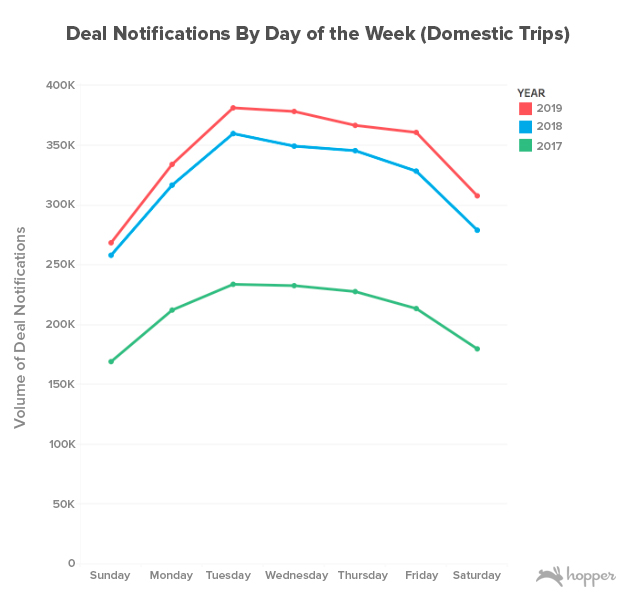
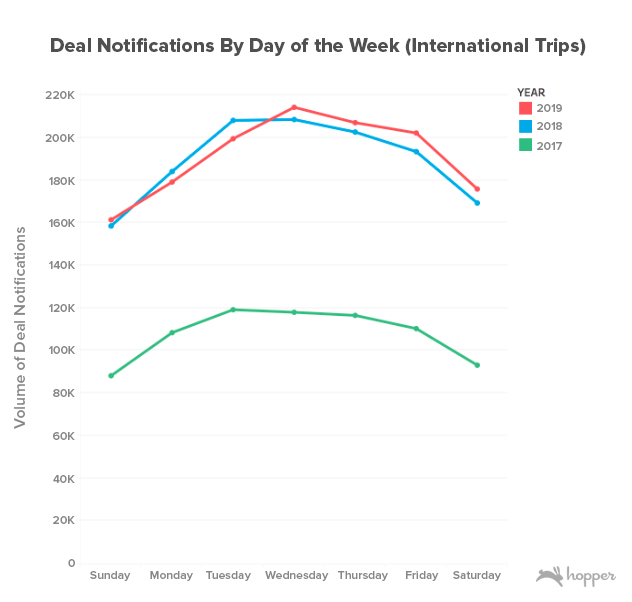
Methodology
Hopper predicts future flight prices with 95% accuracy up to one year in advance of departure. We collect 25 to 30 billion airfare price quotes every day, and have built a historical archive of several trillion prices over the past several years. By combining current prices with historical trends, Hopper can predict how prices are likely to change in the future.
Get the Hopper app to find the best deals.
You could save up to 40% on your next flight!
